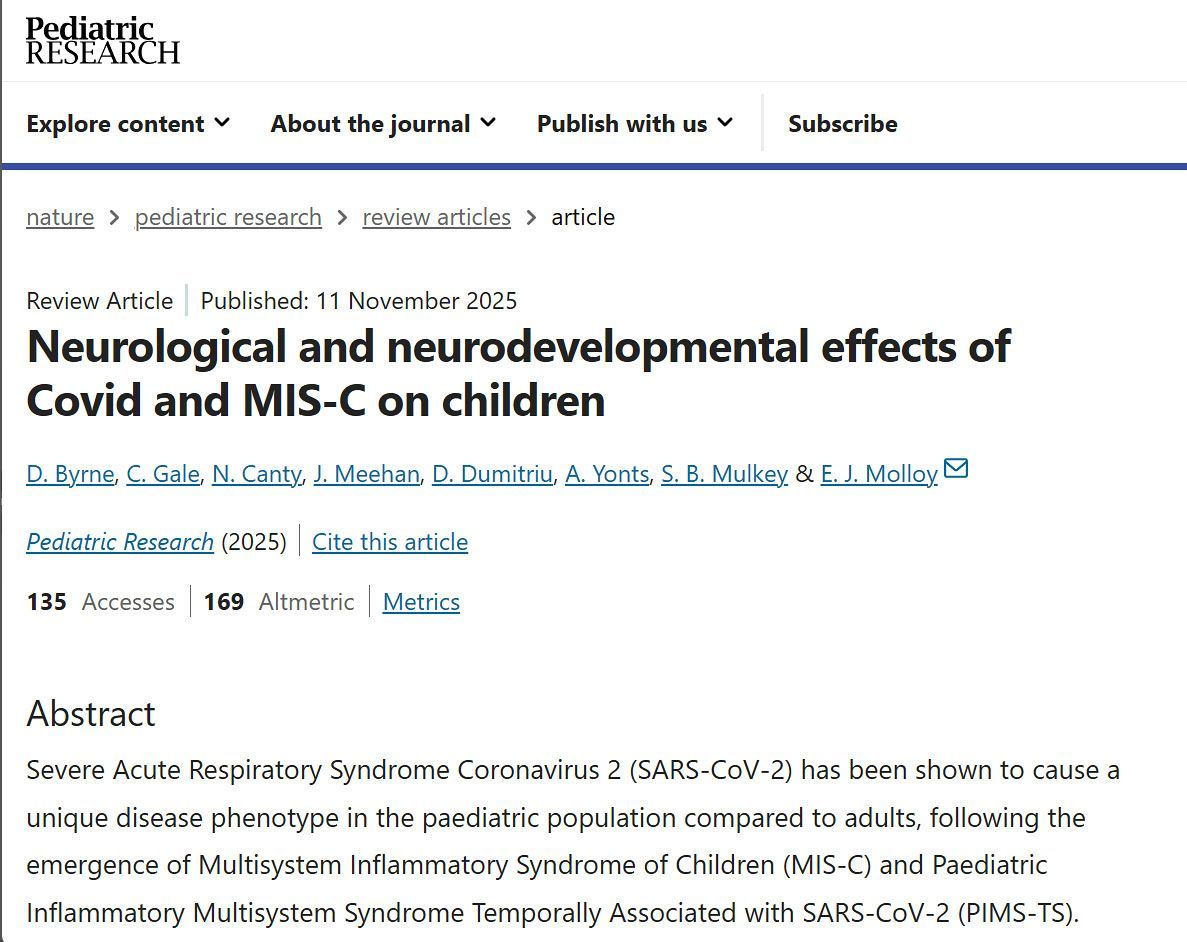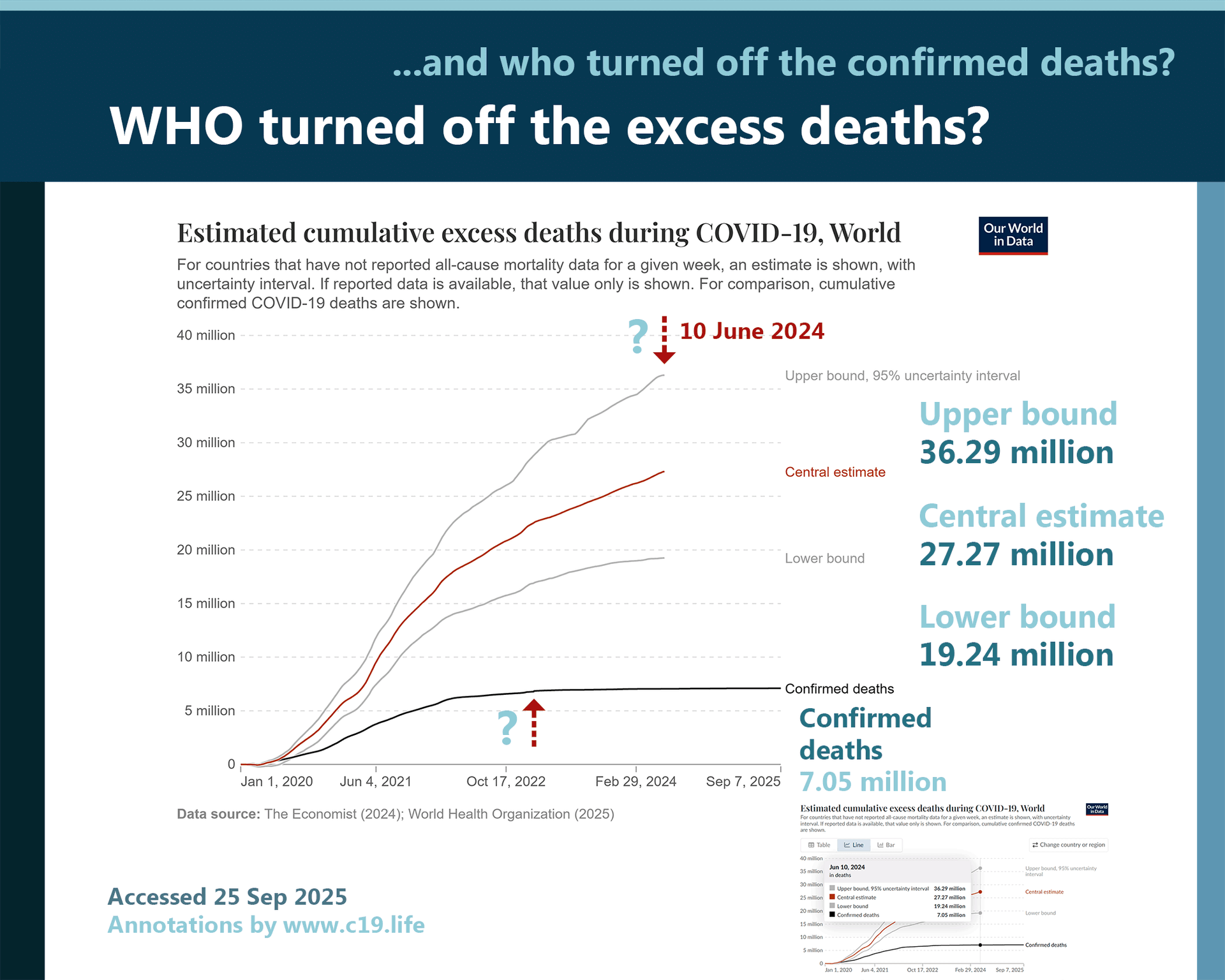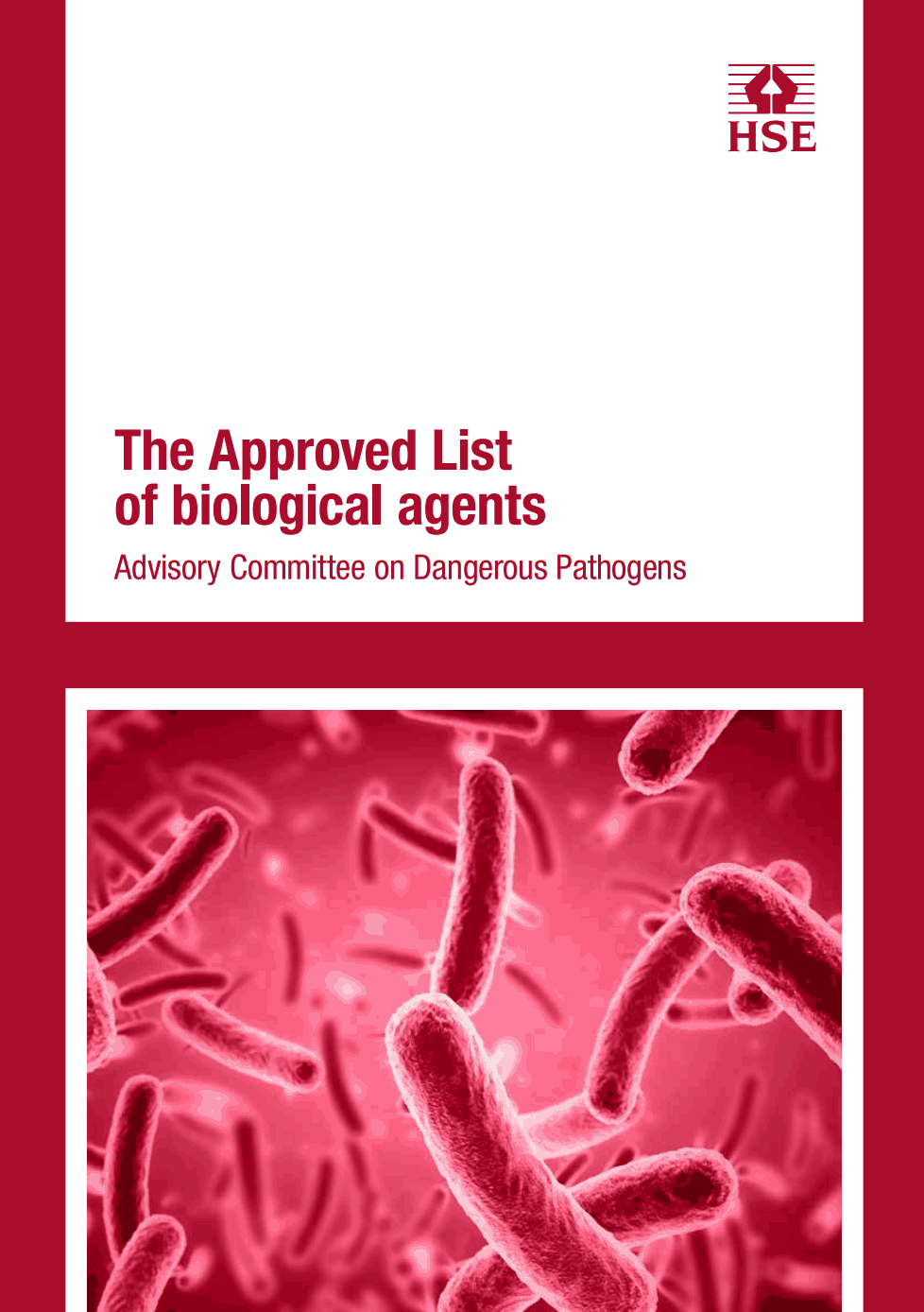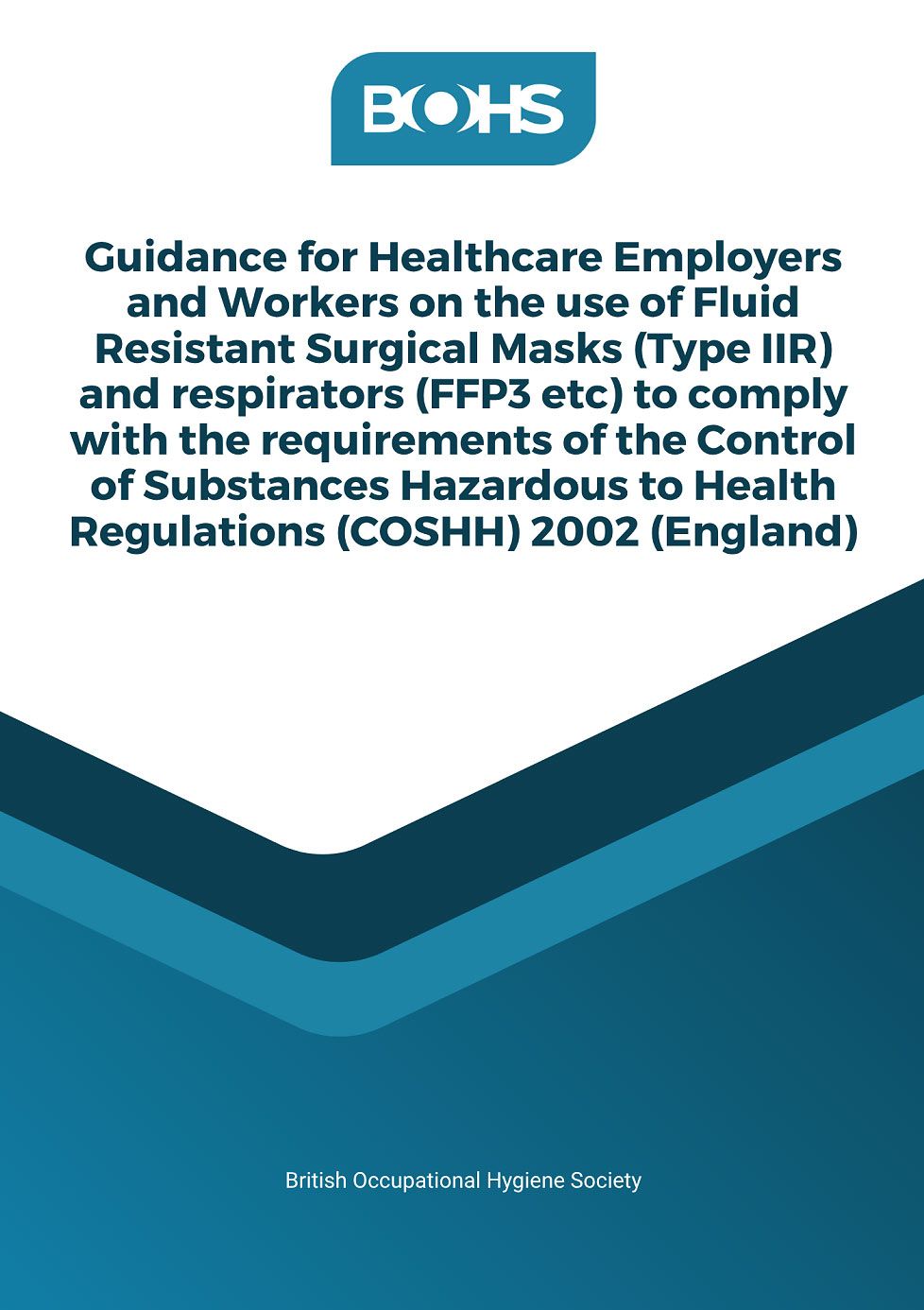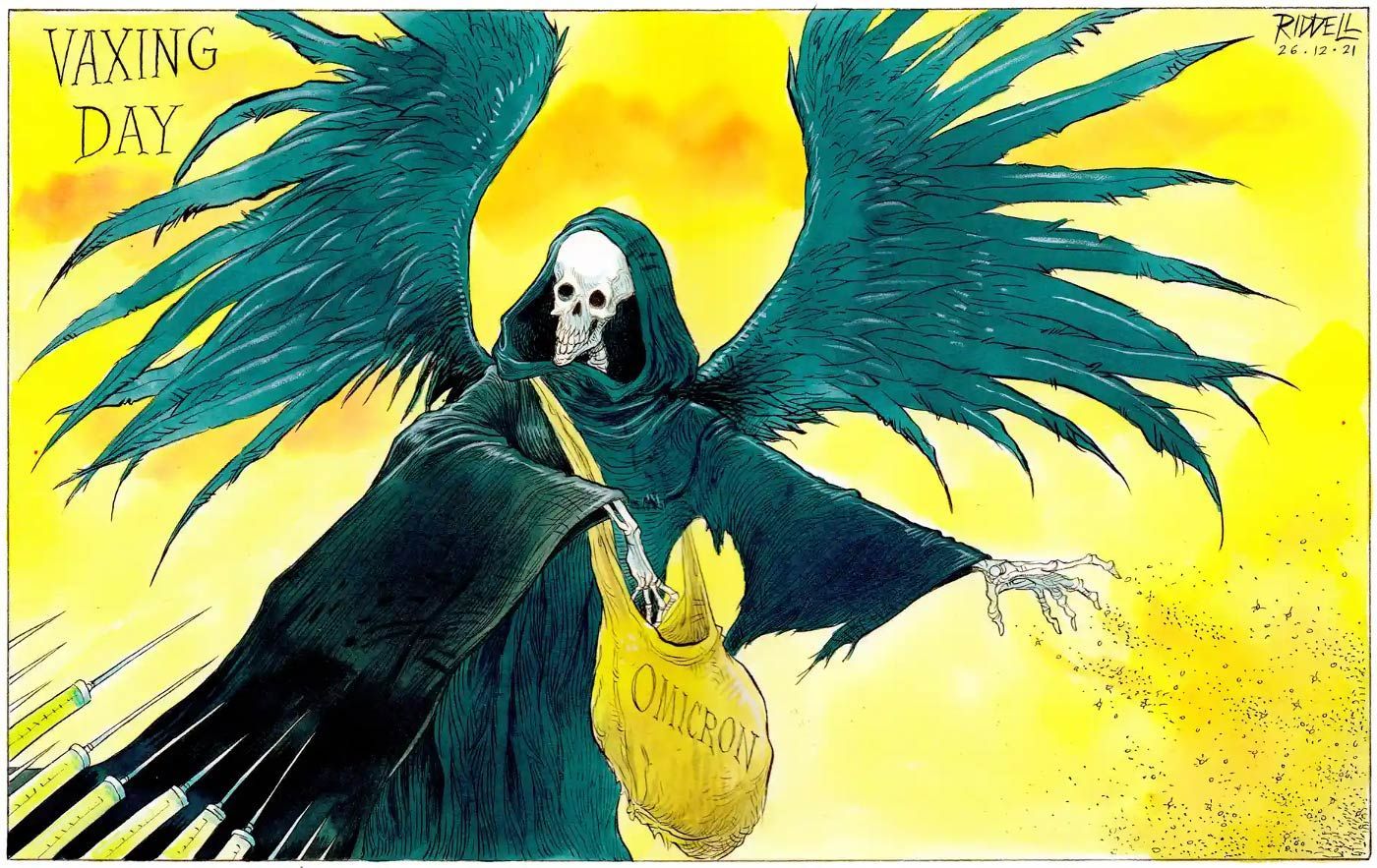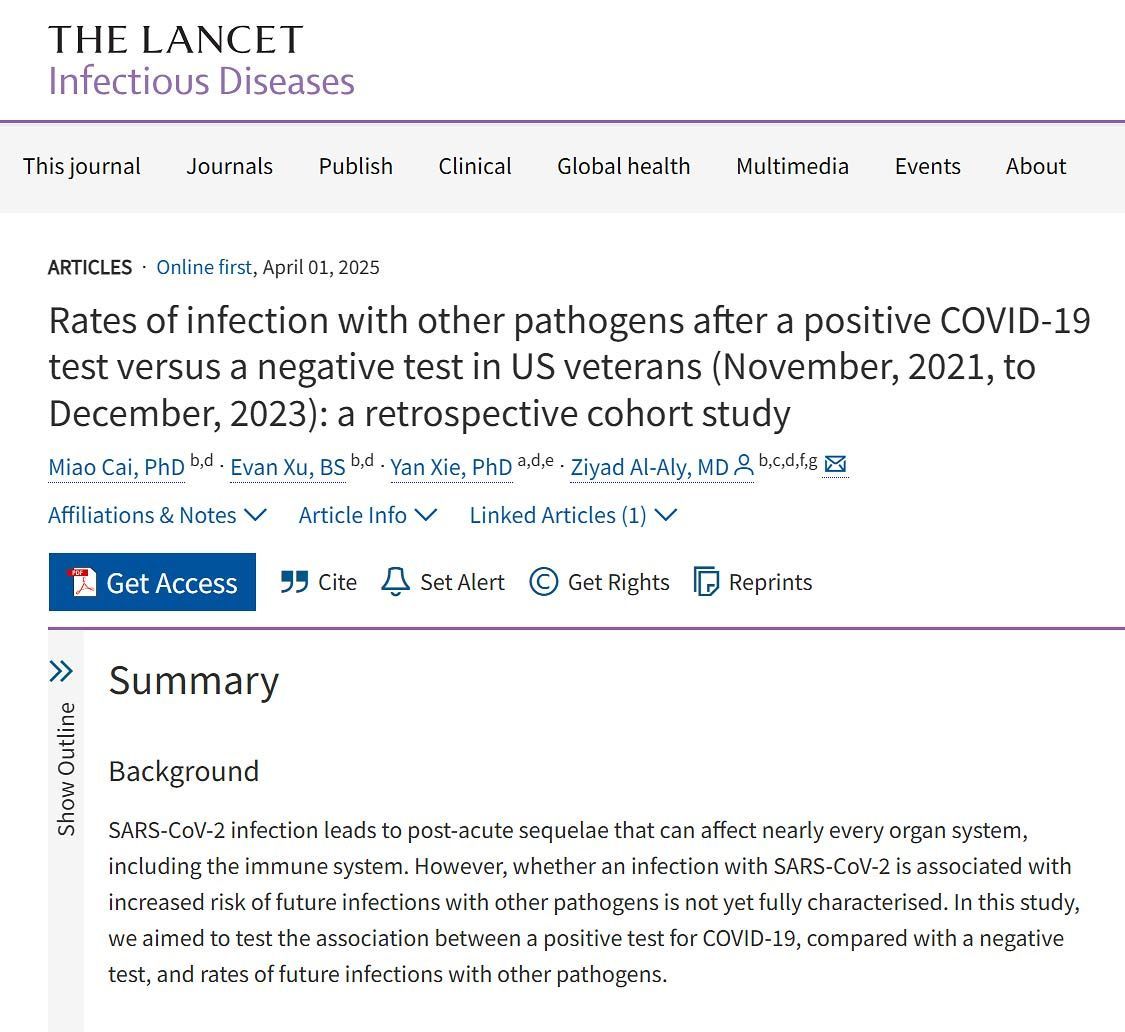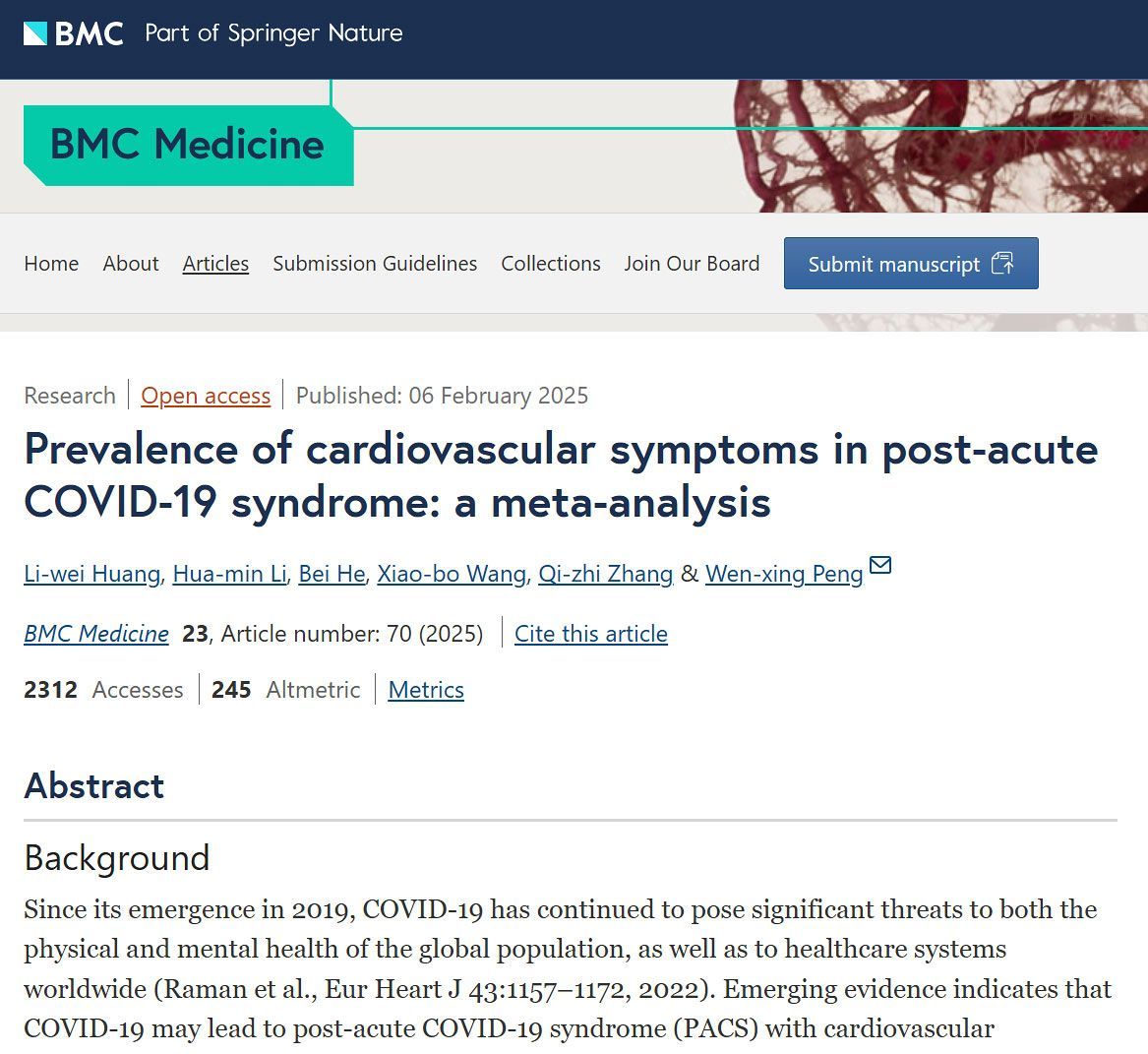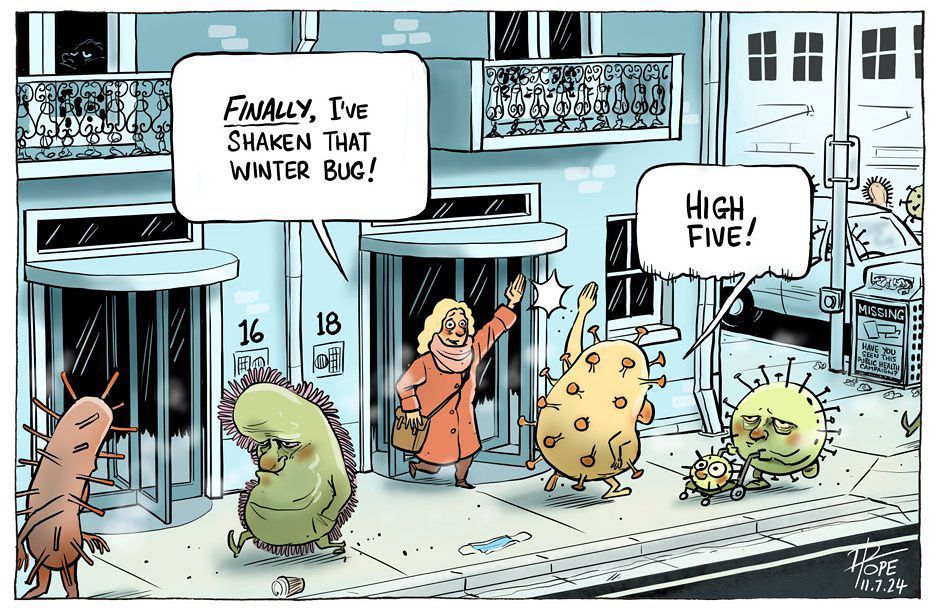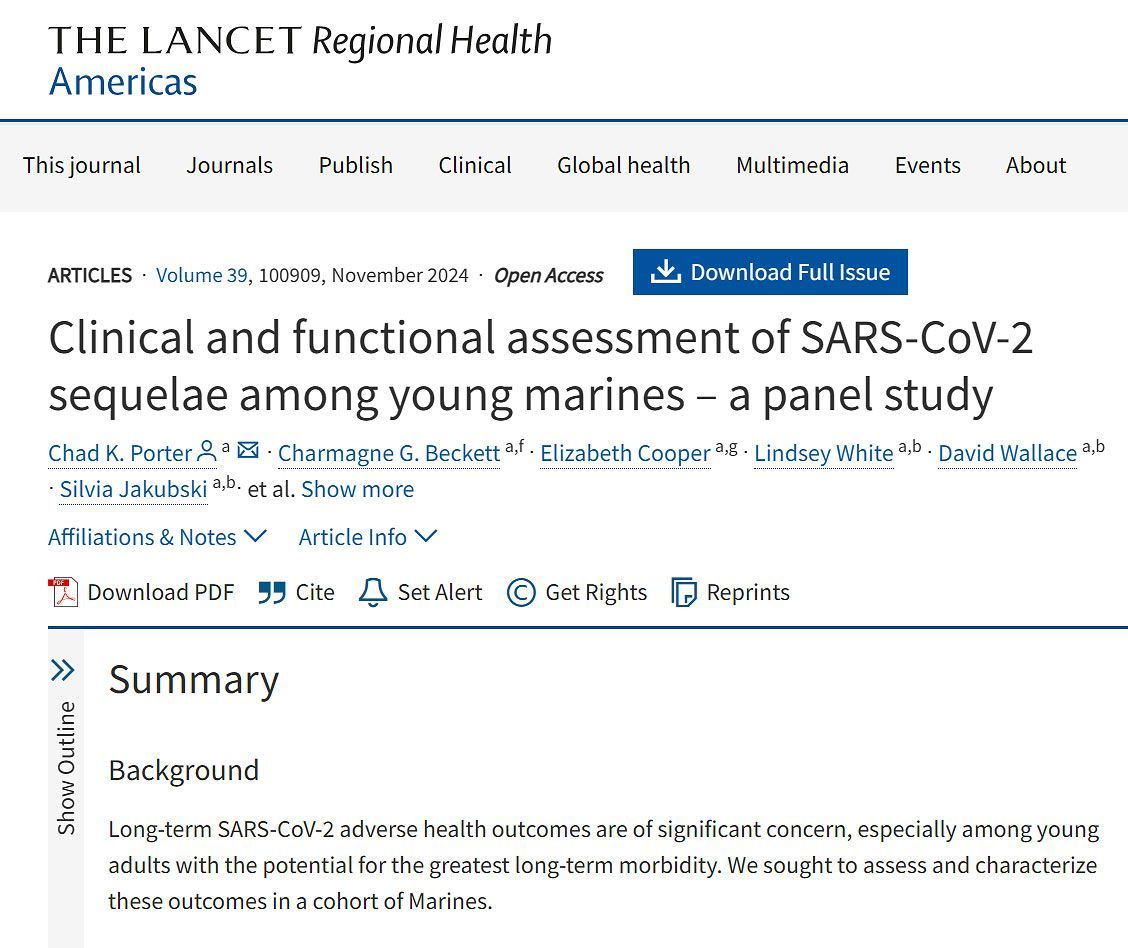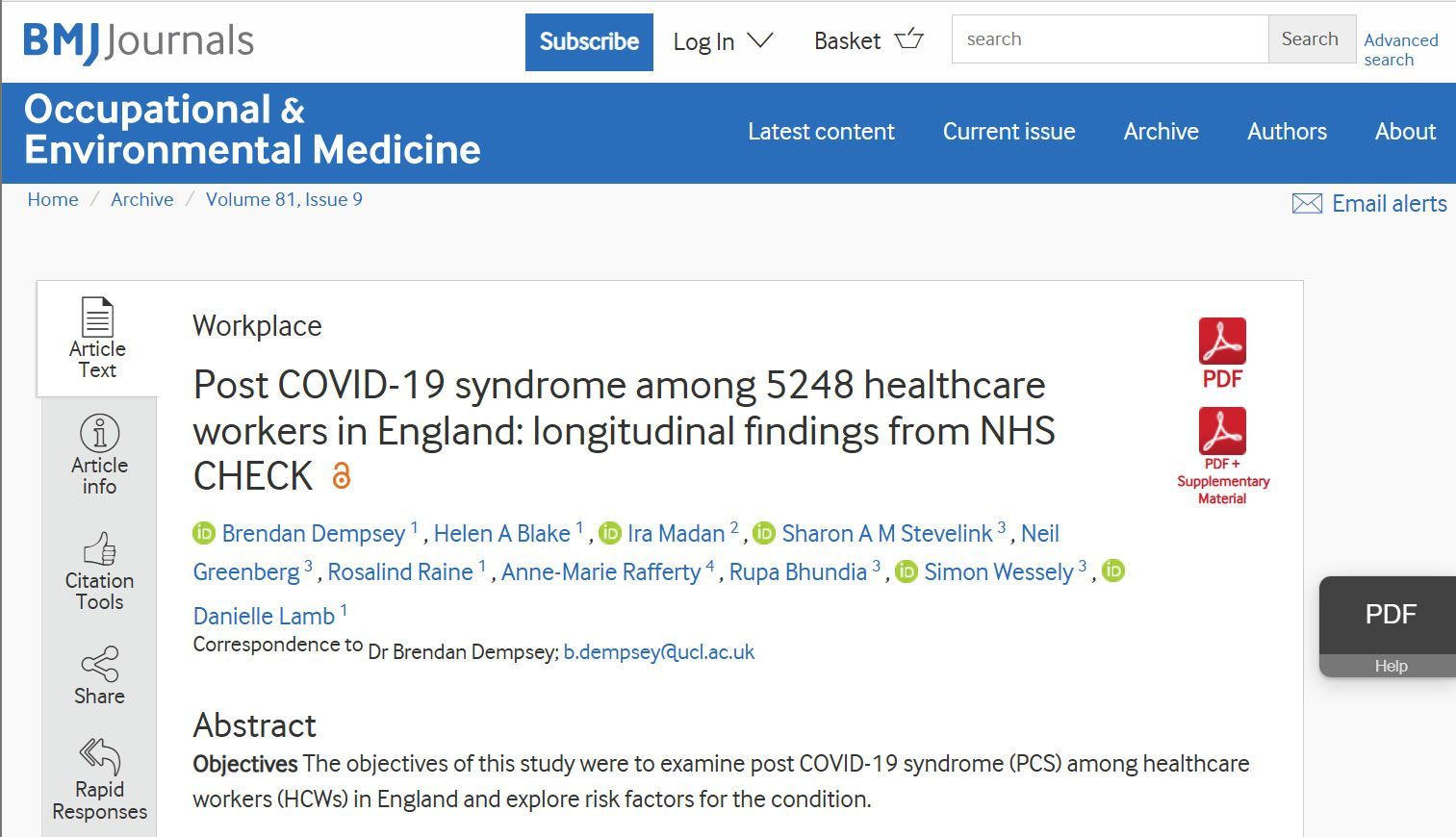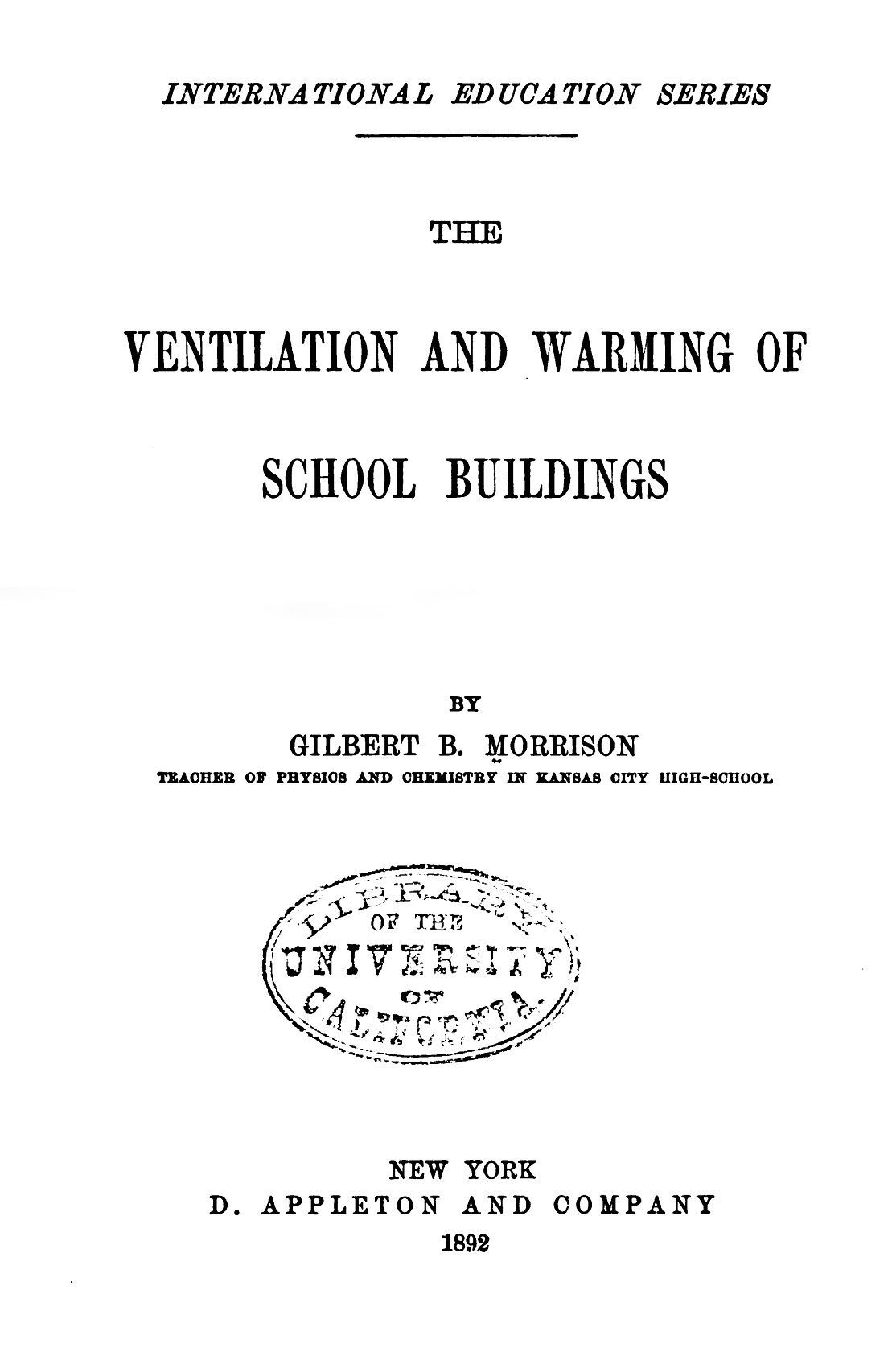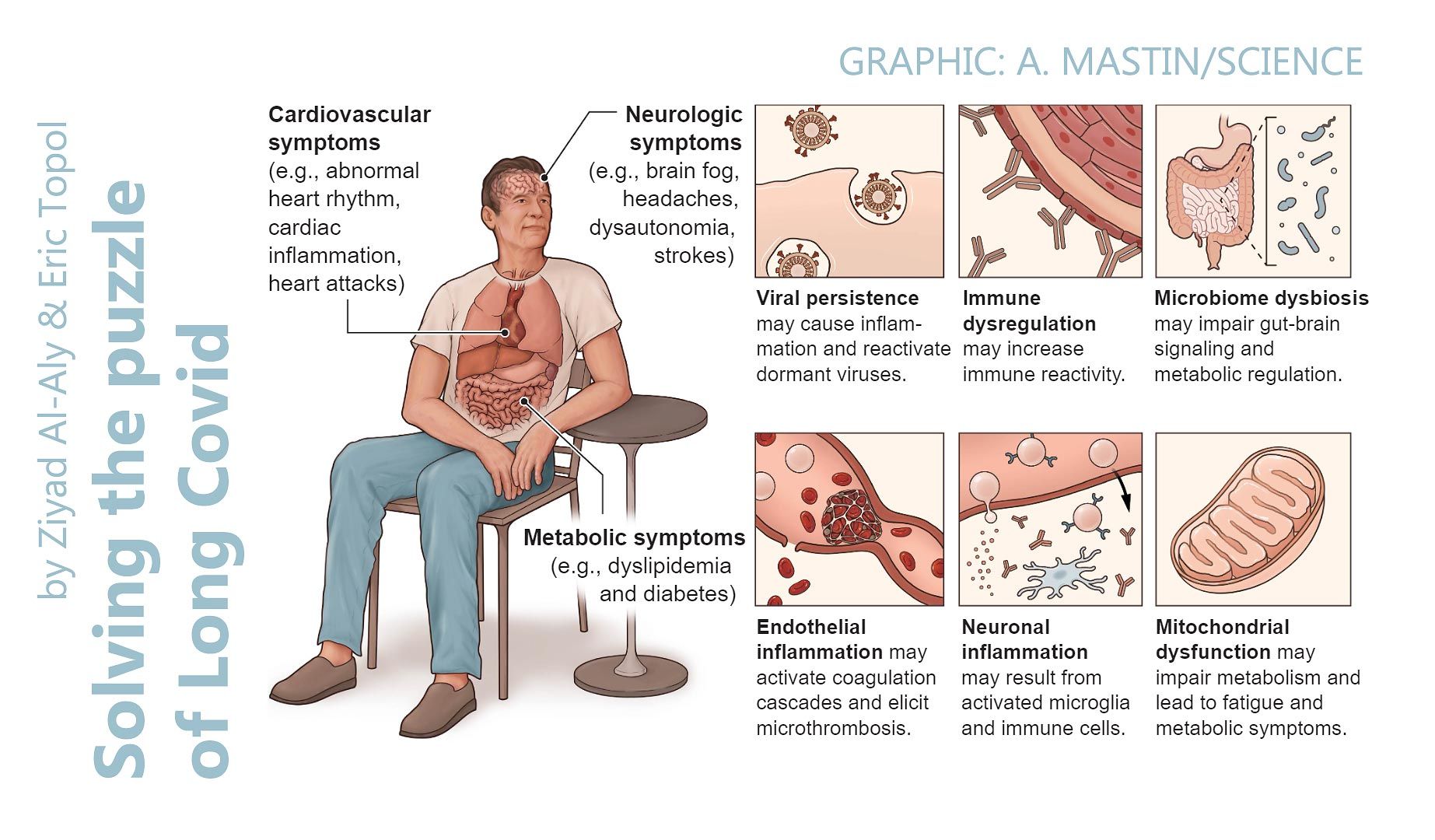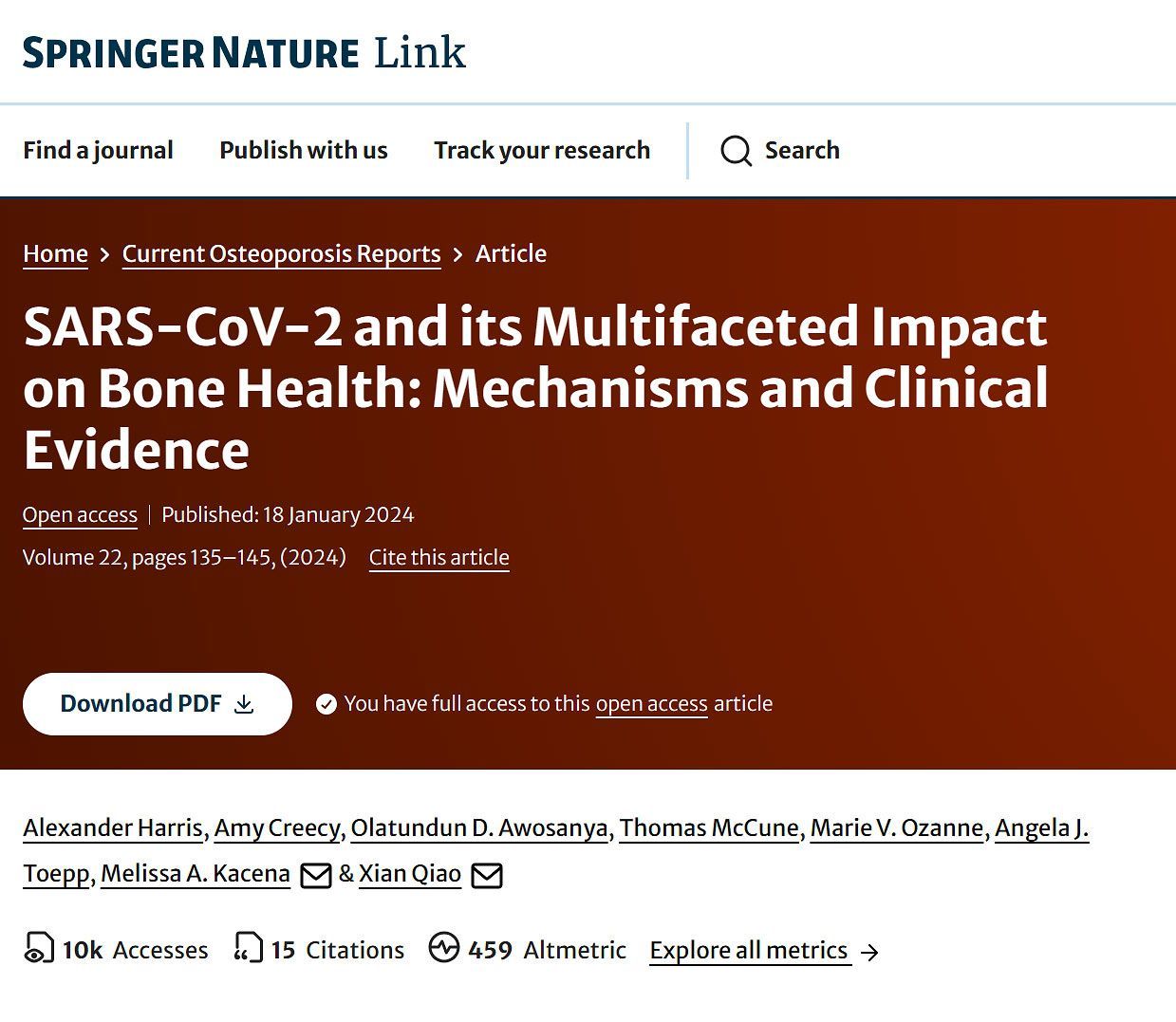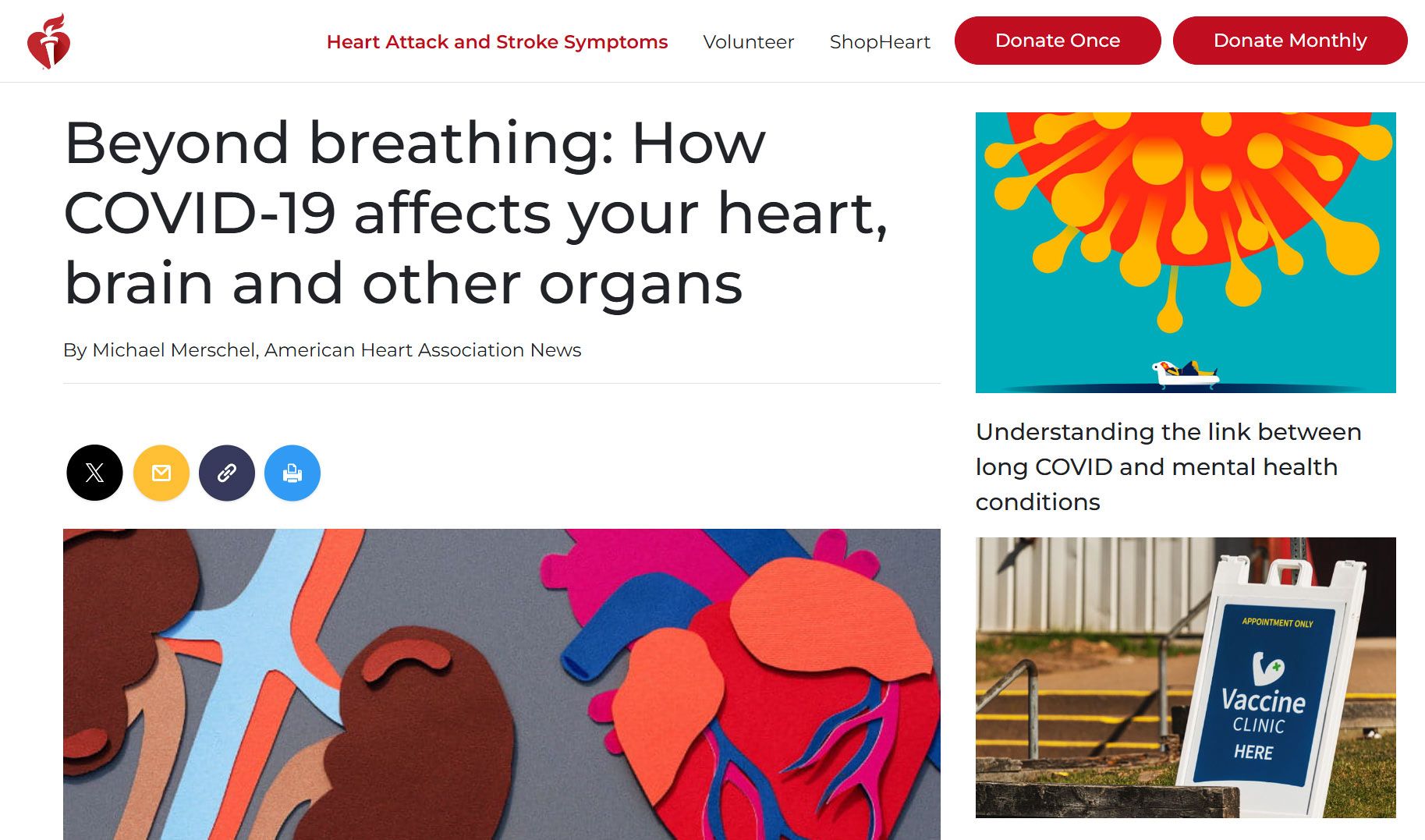C19.life
‘First do no harm; then try to prevent it.’
Professor Geoffrey Hughes, DRCOG, FFAEM, FRCP, FACEM / Emergency Medicine Journal (2007) ➲
❦ the early SARS-CoV-2 (COVID-19) narrative
‘The narrative that COVID-19 had only respiratory sequelae led to a delayed realization of the neurological, cardiovascular and other multi-system impacts of COVID-19 [SARS-CoV-2 infection].’
Nature Reviews Microbiology (2023) ➲
❦ the continuing SARS-CoV-2 narrative of hand-washing for an airborne virus
SARS-CoV-2 – the virus that causes COVID-19 – is airborne.
In May 2021, the WHO officially recognised that SARS-CoV-2 is airborne via microscopic aerosols – meaning that the virus is transmissible through the air at both long and short range.
To extol hand-washing as a primary defence against SARS-CoV-2 is akin to promising a two-pack-a-day smoker that the simple formula of soap + water will prevent chronic obstructive pulmonary disease and lung cancer.
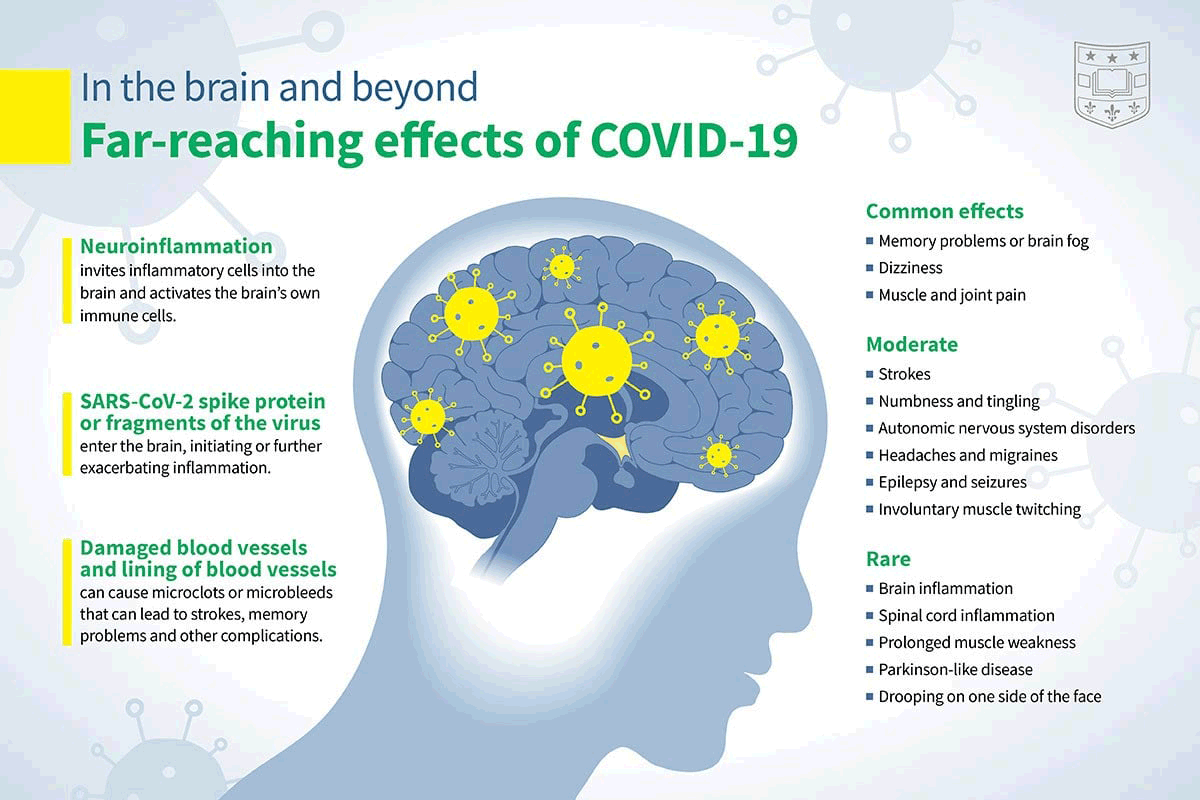
c19.life:
archives
❦ on reinfections and SARS-CoV-2
‘Reinfection, which is now the dominant type of SARS-CoV-2 infection, is not inconsequential; it can trigger de novo Long Covid [PASC] or exacerbate its severity.
Each reinfection contributes additional risk of Long Covid [PASC]: cumulatively, two infections yield a higher risk of Long Covid than one infection, and three infections yield a higher risk than two infections.’
Science (2024) ➲
❦ from lung to multi-organ systems
‘Initially focused on respiratory symptoms, it’s now clear that COVID-19 presents a complex clinical picture affecting various organ systems.
Our findings reveal that a substantial proportion of pediatric COVID-19 patients with neurological symptoms exhibit abnormal neuroimaging findings, with 43.74% of children in the included studies demonstrating such abnormalities.’
Nature Scientific Reports (2024) ➤
❦ on milder initial symptoms, and increased severity of Post-Acute Sequelae of COVID-19 (PASC)
‘While acute [short-term] symptoms of reinfection are generally milder, the severity and incidence rate of long COVID [PASC] increase significantly with the number of reinfections.’
The Lancet: Regional Health (Western Pacific) (2024)

c19.life:
reinfections & vaccination
❦ on vaccine effectiveness
‘Vaccine effectiveness against SARS-CoV-2 infection [COVID-19] declines markedly with time and Omicron variants.’
European Respiratory Review (2025) ➲
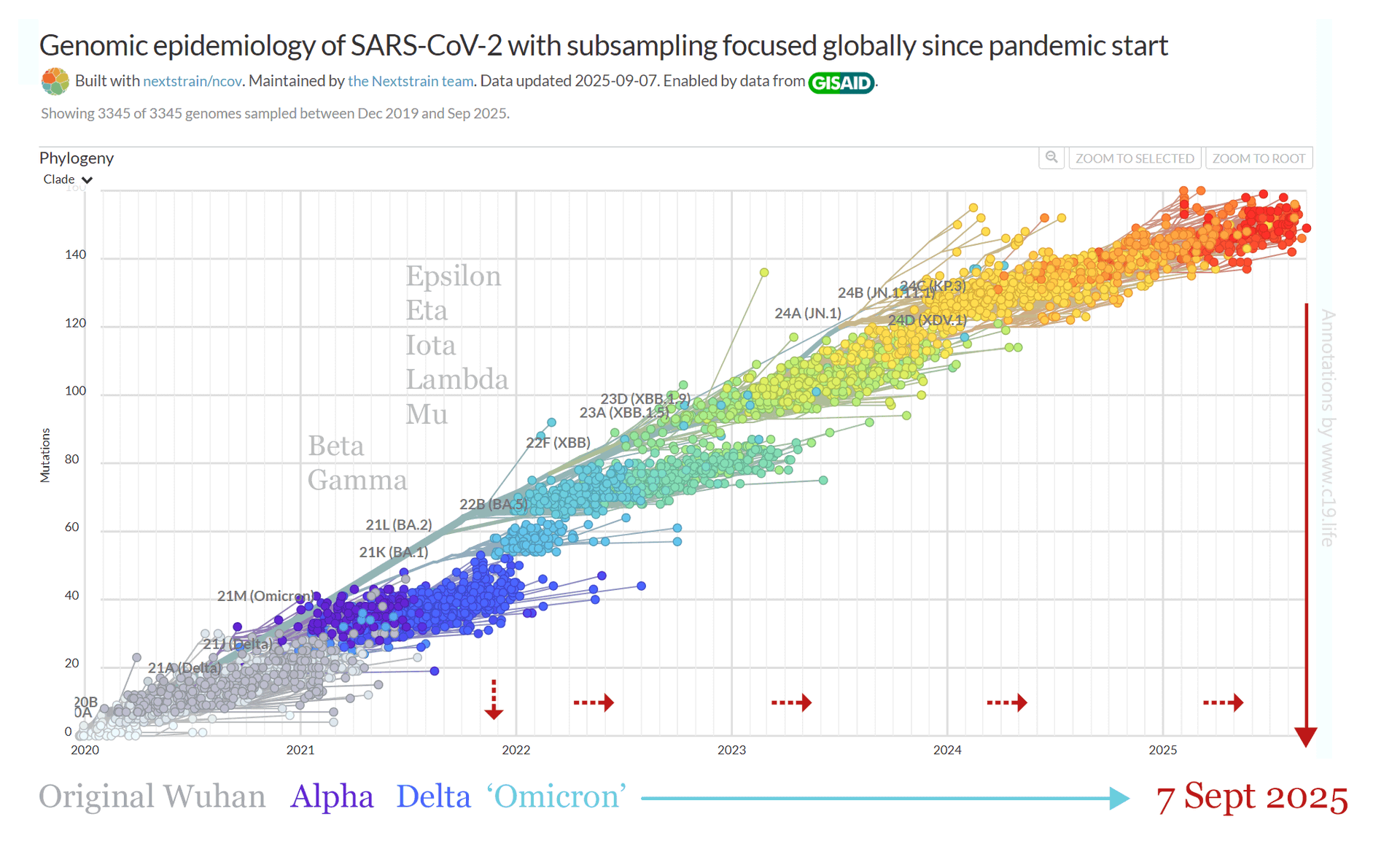
❦ ‘Omicron variants’ during the ‘Omicron Era’ (late 2021–).
© 2025 NextStrain.org / GISAID.org ~ Annotations by C19.Life.
✾ For a full picture, see ‘A WHO’s Who of VOCs, VOIs and VUMs: Alphabet Stew and Numeric Ragout for Dummies’ by C19.Life.

❦ on the ‘hybrid immunity’ pipe dream
‘The arrival of the Omicron variant marked a major shift, introducing numerous extra mutations in the spike gene compared with earlier variants.
Before Omicron, natural infection provided strong and durable protection against reinfection, with minimal waning over time.
However, during the Omicron era [late 2021 to the present], protection was robust only for those recently infected, declining rapidly over time and diminishing within a year.’
Nature (2025) ➲
❦ on lymphopenia (lymphocytopenia)
‘Patients with HIV infection routinely have lymphocytopenia, which arises from destruction of CD4+ T cells infected with the HIV virus.
Patients with COVID-19 also frequently have lymphocytopenia (35% to 83% of patients).
Patients [with frequent lymphocytopenia] have recurrent viral, bacterial, fungal, or parasitic infections.’
Merck & Co. (Merck Manuals) ➲
❦ on the 12-month immunity tail of mild-to-moderate SARS-CoV-2 infections
‘A positive test for COVID-19 is associated with increased rates of diagnosis of various non-SARS-CoV-2 infections in the 12 months following an acute SARS-CoV-2 infection, even if the initial infection is mild to moderate.
Participants with a positive COVID-19 test who were not admitted had significantly increased rates of outpatient diagnosis of bacterial, fungal, and viral infectious illnesses (increased risk of 17%), outpatient respiratory infections (increased risk of 46%), and admission to hospital for infectious illnesses (increased risk of 41%), including for sepsis and respiratory infections.’
CIDRAP / The Lancet: Infectious Diseases (2025) ➲
❦ on indiscriminate killing of T cells, immune “reset”, and the reactivation of dormant viruses
‘SARS-CoV-2 is linked to an unusually high level of ‘indiscriminate’ killing of T cells, reminiscent of measles, which can cause immune amnesia by depleting memory B cells (a different type of immune cell), leaving people vulnerable to pathogens they were previously immune to.
This concept of immune “reset” after infections isn’t new.
A hallmark of this phenomenon is the reactivation of dormant viruses which re-emerge, while the immune system is in a weakened state.
Reactivation of viruses, including Epstein-Barr virus (EBV) and varicella zoster virus (VZV, or ‘Shingles’), has been commonly observed after COVID-19.’
BMJ (2025) ➤
on the heart
‘The incidence of hospitalisation with cerebral infarction [ischaemic stroke] was twice as high after COVID‐19 onset as during the baseline period. Other investigators have estimated the risk of stroke to be 2–13 times as high for people with COVID‐19.’
The Medical Journal of Australia (2022) ➲
❦ one from the heart
‘One year after COVID-19 infection, people were at higher risk of cardiovascular disease – including cerebrovascular disorders, dysrhythmias, ischaemic and non-ischaemic heart disease, pericarditis, myocarditis, heart failure, and thromboembolic disease.
Those who had COVID-19 had a 72% increased risk of heart failure, 63% increased risk of heart attack, and 52% increased risk of stroke compared with controls.’
The British Medical Journal (2022) ➲
on the brain
‘Those infected with the [SARS-CoV-2] virus are at increased risk of developing a range of neurological conditions in the first year after the infection. Such complications include strokes, cognitive and memory problems, depression, anxiety, and migraine headaches.’
Nature Medicine (2022)
❦ on recurrent IQ loss
“There was a recent 2024 study showing us that individuals who survive an acute COVID-19 infection – these are not individuals who are getting diagnosed with long COVID – on average will lose somewhere in the neighbourhood of two to six IQ points per infection.”
David Putrino ~ Canadian Broadcasting Corporation (2025) ➲
❦ on SARS-CoV-2 infections, and rapidly progressive mixed dementia
‘All subtypes of dementia, irrespective of patients’ previous dementia types, behaved like rapidly-progressive dementia following COVID-19.
Cognitive postscripts of COVID-19, characterized by multi-domain cognitive impairments, are now being reckoned as the most devastating sequelae of COVID-19.’
Journal of Alzheimer’s Disease Reports / EurekAlert (2023) ➲
On SARS-CoV-2 (COVID-19), brain damage, neurological damage, and dementia ➲
❦ on mildness and cognitive decline
‘Strikingly, even asymptomatic and mild-diseased patients may evolve with important neurological and psychiatric symptoms such as confusion, memory loss, cognitive decline and chronic fatigue, associated or not with anxiety and depression.’
Human Genetics (2023) ➲
❦ on ‘Omicron’ and neuroinvasive capabilities
‘Interestingly, the findings confirmed epidemiological observations showing acute disease severity is reduced in Omicron [re]infections – however, all [SARS-CoV-2] variants demonstrated similar neuroinvasive capabilities.’
Nature Communications / New Atlas (2023) ➲
❦ on posterity
‘Regarding the different cognitive functions, our results reveal that attention is the one that shows the greatest deficit, regardless of the age of the patients (more than 25% of patients in each age group exhibit a moderate attention deficit).
Processing speed was also a cognitive process that was impaired relatively homogeneously across age groups; however, the results indicate that the youngest patients show a much slower processing speed (33.3% of those under 50 years of age) compared to the oldest (5.1% of those over 50 years of age).
The highest percentage of patients with severe verbal memory impairment was also found in the younger patients group.
In long-term memory, 20.7% of the youngest group showed a severe deficit and 24.1% a mild impairment, while a minimum proportion of the elderly showed alterations in this area.
In conclusion, the results presented here reveal that at least 85% of the participants exhibit deficits in one neuropsychological test.
Also, the youngest patients were those who showed the most marked and heterogeneous cognitive impairment.’
Nature Scientific Reports (2023) ➤
❦ on siding with the precautionary principle
The precautionary principle is a risk-management approach that advocates for preventative action in the face of scientific uncertainty when there is a potential for serious or irreversible harm to human health.
❦ The precautionary principle
a. Take anticipatory action to prevent harm in the face of scientific uncertainty.
b. Explore alternatives, including the alternative of ‘no action’ (i.e. “Let’s learn to live with the virus”).
c. Consider the full cost of health impacts over time.
C19.Life
on the body
On SARS-CoV-2 reinfections, Post-Acute Sequelae of COVID-19 (PASC) (‘Long Covid’), multi-organ system damage, and viral persistence.
Also see:
❦ on recurring, whole-body damage
‘The data show a consistent pattern of increased likelihood of hospitalization, cardiovascular effects, clotting and other blood disorders, diabetes, fatigue, gastrointestinal distress, kidney damage, mental health effects such as depression, musculoskeletal damage, neurological deficits and pulmonary damage’ with each new reinfection.
‘The risk of hospitalization, organ damage and death rises markedly with repeat COVID-19 infection.’
Harvard Magazine (2022) ➤
❦ on recovered cancer patients, and accelerated cancer development
‘Recent research indicates that SARS-CoV-2 infection and COVID-19 progression may predispose recovered patients to cancer onset and accelerate cancer development.’
International Journal of Molecular Sciences (2023) ➲
❦ on time-lag, and multi-organ infection persistence
‘SARS-CoV-2 can cause persistent infections in many parts of the body, months past an initial illness.
SARS-CoV-2 RNA was detected in 84 different locations in the body.
The
highest burden
of
viral RNA
was found in
airway
and
lung tissue
– however, the
virus
was
also detected
in the
brain,
gut,
heart,
kidney,
eye,
adrenal gland
and
lymph nodes.’
Nature / New Atlas (2023) ➲
on immunity
“People do become very worried if you compare COVID-19 to HIV, but actually HIV has good treatment and life expectancy now.” ➲
Dr. Noor Bari, Emergency Medicine (2023)
❦ on the hygiene hypothesis, pathogenic viruses, and ‘immunity debt’ pseudoscience
‘The hygiene hypothesis is the idea that the immune system needs to be “trained” during childhood to properly develop immune tolerance to microbes, but it specifically refers to bacteria, protozoans and helminths, most of which are normally beneficial, neutral, or not significantly harmful to humans.
It does not advocate repeated exposure to viruses, especially highly pathogenic ones.’
The John Snow Project (2023)
“Three years ago, I never would have believed that I’d one day see scientists and MDs [medical doctors] promoting the idea that it’s good for infants and young toddlers to be exposed to dangerous respiratory viruses like flu and RSV, instead of trying to delay those first infections – and yet here we are.”
Dr. Lisa Iannattone, Assistant Professor of Dermatology (2022) ➲
❦ on breathing in... asthma, COPD, ILD, and lung cancer
‘Our study showed a significant increase of the long-term risk of developing asthma, COPD, ILD, and lung cancer among individuals who suffered SARS-CoV-2 reinfection.’
COPD = Chronic obstructive pulmonary disease.
ILD = Interstitial lung disease.
The Lancet: eClinical Medicine (2024) ➲
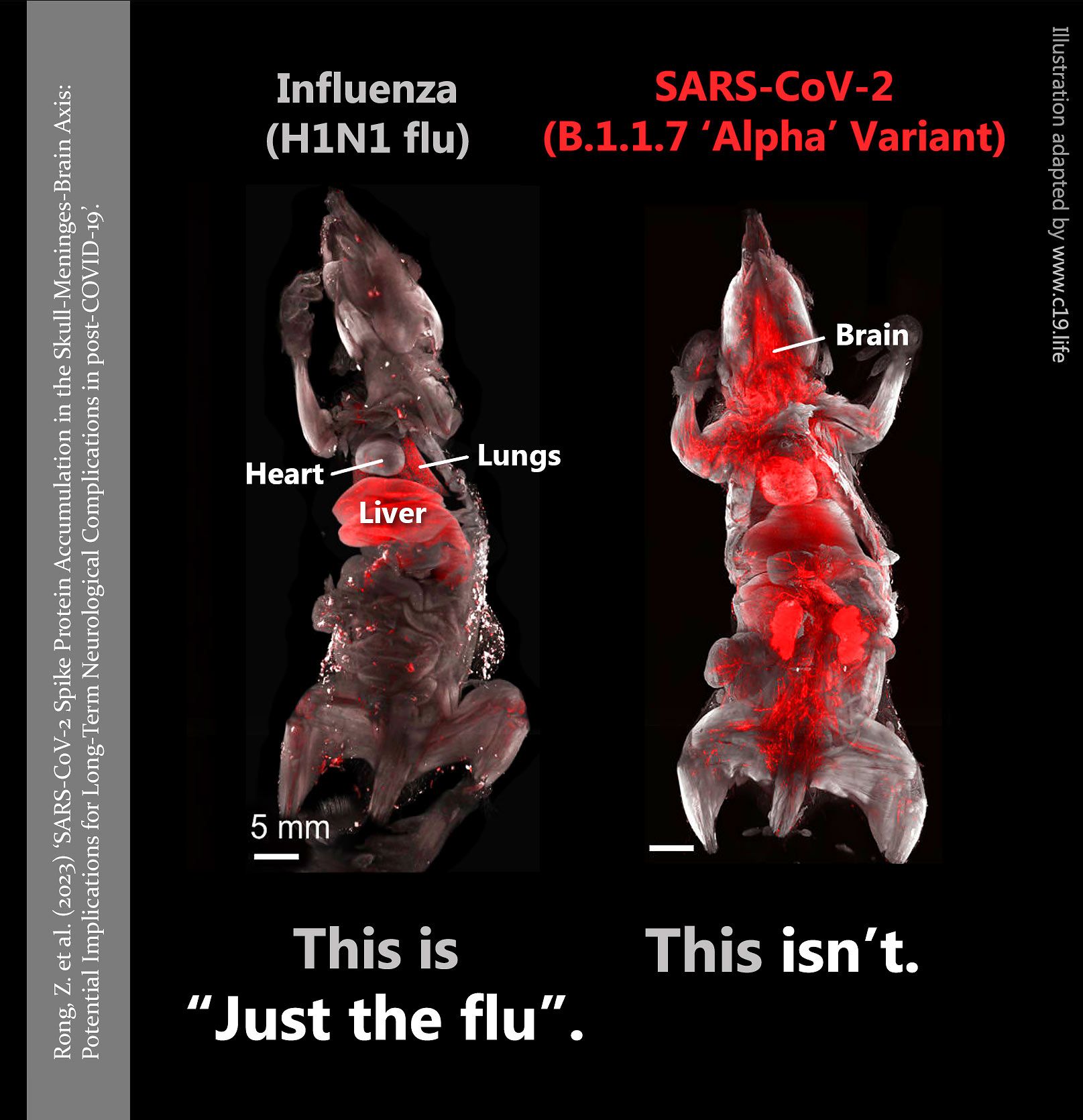
❦ on the immune system, and repeat SARS-CoV-2 infections
‘Repeated exposure to a virus such as SARS-CoV-2 will fast-track more people into immunosenescence at ever-earlier ages, with potentially serious repercussions for their health and longevity.’
The John Snow Project (2023) ➲
➲ Immunosenescence ~ The gradual deterioration of the immune system, normally brought on by natural age advancement.
Immunosenescence is closely related to the development of infections, autoimmune diseases, and malignant tumours.
on pregnancy & reproduction
On SARS-CoV-2 infections, female and male infertility, pregnancy complications, and disruption of the reproductive cycle.
❦ on male impotence and SARS-CoV-2 infection (COVID-19)
‘Statistics are significant regarding the link between COVID-19 and impotence.
“We found the risk of getting diagnosed with erectile dysfunction (ED) was about 20% higher in men who had COVID versus those who did not.”
Survey studies support the notion of a link between ejaculation difficulty and the virus – a study of nearly half a million adults published in Nature identified ejaculation difficulty and reduced libido as Long COVID symptoms in men.’
Fortune (2022) ➲
❦ on female and male infertility, and pregnancy loss
‘SARS-CoV-2 is speculated to affect the ovary, lessen the ovarian reserve function, and cause infertility or pregnancy loss.
Several studies have suggested that SARS-CoV-2 can indirectly affect fetal growth in pregnant women.
Studies also suggest that the expression of ACE2 in testicular cells is associated with age. The highest expression was reported in the 30-year-old age group, while the lowest was reported in the 60-year-old group.
COVID-19 infection could result in more severe testicular damage in young men than older men.
SARS-CoV-2 infections in males have also been associated with a higher risk of male sterility.’
American Journal of Translational Research / News Medical Life Sciences (2022) ➤
❦ on neonates, maternal SARS-CoV-2 infection, placentitis, and severe outcomes
‘Maternal SARS-CoV-2 infection has been associated with increased adverse events in the mother, as well as increased stillbirths, spontaneous abortions, and premature delivery.
SARS-CoV-2 placentitis is a well-documented outcome of symptomatic and asymptomatic COVID-19 infection during pregnancy.
It can disrupt placental function and lead to severe outcomes in the neonate, including growth restriction and stillbirths.’
Archives of Pathology & Laboratory Medicine (2025) ➤
❦ on SARS-CoV-2 and foetal brain haemorrhages
‘Strikingly, the [foetal brain] haemorrhages are predominately found in the late first and early second trimester of gestation.
Specifically, the majority were between 12 and 14 PCW [post-conception week], a critical window of human foetal brain development when the endothelial tight junctions increase to form the blood-brain barrier.
Our observations of disrupted foetal cerebral vasculature are consistent with reports of damage to the microvasculature of the adult brain in SARS-CoV-2 infected patients.’
Brain (2023) ➤
❦ breathing out: reduced foetal lung growth
‘In pregnant women who tested positive for SARS-CoV-2, normalised fetal lung volume was significantly reduced.
The timepoint of infection showed significant effects on fetal lung growth, with reduced lung volumes observed with SARS-CoV-2 infections acquired during the third trimester.’
The Lancet: Respiratory Medicine (2022) ➤
on babies & children
‘Death is not the main risk facing most children [regarding repeat SARS-CoV-2 infections].
Disability is.’
Calgary Herald (2023) ➲
❦ Generation C-19
‘Long COVID [PASC] impacts children of all ages.
One study found that fatigue, headache, dizziness, dyspnoea, chest pain, dysosmia, dysgeusia, reduced appetite, concentration difficulties, memory issues, mental exhaustion, physical exhaustion and sleep issues were more common in individuals aged 15–19 years compared with controls of the same age.
Similarly to adults with long COVID, children with long COVID experience fatigue, post-exertional malaise (PEM ➲), cognitive dysfunction, memory loss, headaches, orthostatic intolerance, sleep difficulty and shortness of breath.
Children experiencing Long COVID have hypometabolism in the brain similar to the patterns found in adults with Long COVID.
Children with Long COVID were more likely to have had attention deficit hyperactivity disorder, chronic urticaria (‘hives’) and allergic rhinitis before being infected.’
Nature Reviews Microbiology (2023) ➲
❦
Cognitive dysfunction =
deficits in
attention,
verbal
and
non-verbal learning,
short-term
and
working memory,
visual
and
auditory processing,
problem-solving,
processing speed, and
motor functioning.
❦ on spinning the roulette wheel
‘The prevalence of Long COVID [PASC] in children and adolescents was 25.24%.
The five most prevalent clinical manifestations were mood symptoms (16.50%), fatigue (9.66%), sleep disorders (8.42%), headache (7.84%), and respiratory symptoms (7.62%).’
Nature (2022) ➲
❦ on hope
‘We are just hoping kids will be OK. I don’t see how they will be. The data suggest they won’t be.’
Calgary Herald (2023) ➲
❦ on naïvety, and neglect of pragmatism
“Because children haven’t been exposed to many viruses, their immune system is still ‘naive’.
And because they don’t develop memory T cells, they are at risk of getting sick when they become reinfected.
With each new infectious [SARS-CoV-2] episode as they get older, there is a risk of their T cells becoming ‘exhausted’ and ineffective, like the T cells in older people.
The price that children pay for being so good at getting rid of the virus in the first place is that they don’t have the opportunity to develop ‘adaptive’ memory to protect them the second time they are exposed to the virus.”
Clinical Immunology / News Medical Life Sciences (2023) ➲
on air: transmission
“Infection control guidelines are fundamentally flawed: SARS-CoV-2 is airborne.”
Dr. K. Fearnley, NHS (England) (2023)
❦ pushing human fodder up the ‘frontline’
‘Our very serious concerns relate to the risk of aerosol/airborne infection; RCN and BMA members working in all settings are raising concerns that they are not adequately protected.
Our members are concerned that fluid repellent surgical face masks and face coverings, as currently advised in most general healthcare settings, do not protect against smaller more infective aerosols.’
Royal College of Nursing (RCN/UK) / British Medical Association (BMA) (21 Jan 2021) ➲
❦ on a level-3 biohazard
“Infection control guidelines are fundamentally flawed: SARS-CoV-2 is airborne.
It is outrageous that three-and-a-half years into this pandemic, staff and patients are still, knowingly and repeatedly, being exposed to a level-3 biohazard – a virus known to cause brain damage and significantly increased risk of life-threatening blood complications even in those recovered.”
Dr. K. Fearnley, NHS (England) (2023) ➲
❦ on nosocomial (‘hospital-acquired’ or ‘healthcare-associated’) infection (HAI)
“Every single case in which a person with COVID-19 infects another person in a healthcare setting – patient, relative, or hospital staff member – is a significant failure of hospital procedures.
Every single instance.”
Professor Steve Robson MPH MD PhD ~ President, Australian Medical Association (2024)
❦ on Biosafety Levels
➲ Biosafety Level 2 (BSL-2) ~ Agents that can cause severe illness in humans.
BSL-2 pathogens include HIV, Zika virus, Hepatitis A, B & C, Dengue, and Salmonella.
➲ Biosafety Level 3 ~ SARS-CoV-2, the virus that causes COVID-19, is a Biosafety Level 3 (BSL-3) causative agent.
Other BSL-3 examples include the Yellow fever virus, West Nile virus, Yersinia pestis causing plague, and the bacterium Mycobacterium tuberculosis that causes tuberculosis (TB).
Biosafety Level 3 pathogens can cause serious or potentially lethal disease in humans.
➲ Biosafety Level 4 ~ The highest biosafety level.
Pathogens that pose a high risk of life-threatening disease for which there are no treatments.
BSL-4 examples include the Ebola virus, Marburg virus, and Lassa virus.
❦ on Victorian-style standards
‘It may seem a strange principle to enunciate as the very first requirement in a Hospital that it should do the sick no harm.’
from ‘Notes on Hospitals’ by Florence Nightingale (3rd edition, 1863) ➤
❦ on negligent chains of airborne SARS-2 transmission
“I think a big problem is that many people’s conceptions of morality do not extend to invisible viral transmission and indirect chains of harm.
Punching someone in the face and bloodying their nose is unconscionable.
Killing a hundred people in a chain of negligent transmission?
No biggie.”
Blake Murdoch (2023)
❦ on source control, and widespread household transmission
‘The magnitude of the outbreak illustrates how younger children infected from diverse pediatric facilities can be a major source of widespread household transmission.
Environmental control interventions, such as improved ventilation systems, upper-room ultraviolet germicidal irradiation, or portable high-efficiency particulate air-filtration [HEPA] appliances, may offer sustained benefits in stemming the virus transmission in pediatric facilities.’
❦ on near- and far-range airborne aerosol spread of SARS-CoV-2
‘There is robust evidence supporting the airborne transmission of many respiratory viruses, including measles virus, influenza virus, respiratory syncytial virus (RSV), human rhinovirus (hRV), adenovirus, enterovirus, severe acute respiratory syndrome coronavirus (SARS-1), Middle East respiratory syndrome coronavirus (MERS-CoV), and severe acute respiratory syndrome coronavirus 2 (SARS-CoV-2 / COVID-19).
This [airborne] route dominates... in indoor environments that are poorly ventilated.’
Science (2021) ➤
❦ on clean hands, dirty air, bags of HAIs, and gagging on the Semmelweis Reflex
“From the moment healthcare workers discovered how effective [FFP2/FFP3] respirators were, the whole ethics around the spread of all airborne viruses changed.
It’s not OK to wander around, especially in hospitals, spreading germs that can kill patients.
Not COVID-19, not flu, not RSV – none of it.”
Dr. Noor Bari, Emergency Medicine (2023) ➲
“We are drunk-driving in healthcare... with a pathogen that has a 10% fatality rate in that setting.”
Dr. Noor Bari (2023) ➲
on air: solutions
“There is no way out of this problem that does not involve suppressing transmission of C-19.”
Dr. Noor Bari, Emergency Medicine (2023)
❦ the cost of providing hospitals and schools with uninfected air versus the price of a human life
“Droplets and surfaces are very convenient for people in power – all of the responsibility is on the individual.
On the other hand, if you admit [SARS-CoV-2] is airborne, institutions, governments and companies have to do something.”
Professor Jose-Luis Jimenez (2 Oct 2021) ➤
❦ on clean air, water and food
“We regulate water safety and food safety in an effort to decrease population rates of waterborne and foodborne illnesses.
Having clean air standards to lower the rates of respiratory illnesses isn’t radical.”
Dr. Lisa Iannattone, Assistant Professor of Dermatology (2023) ➲
❦ on abandonment, and duties to care
“Healthcare workers must be provided with respiratory protection, and the air quality in hospitals be monitored and improved through the installation of ventilation systems and air filter units.”
Dr. K. Fearnley, NHS (England) (2023) ➲
❦ The Health & Safety At Work Act (1974)
‘The law imposes a responsibility on the employer to ensure safety at work for all their employees.
Failure to do so could result in a criminal prosecution in the Magistrates Court or a Crown Court.
Failure to ensure safe working practices could also lead to an employee suing for personal injury or in some cases the employer being prosecuted for corporate manslaughter.’
UK General Acts (1974) ➲
❦ on prevention (and the cure)
‘The public health responses to COVID-19 have been based on the faith that this coronavirus is a one-time, short-term event and that after a period of lockdowns and facemasks, vaccines will bring about a return to normal.
This faith is, in fact, historical amnesia.
‘History has shown that most diseases are stopped by shutting down disease transmission, not late-arriving vaccines or hospital treatments.’
The most enduring way to stop transmission is via engineered public health systems.’
from ‘Public Health is a Job for Engineers’ by Charles Forsberg / Mechanical Engineering (2022) ➤ [PDF]
❦ on 21st-century nightingale hospitals
‘In surgical wards, one duty of every nurse certainly is prevention.’
from ‘Notes on Nursing’ by Florence Nightingale (2nd edition,1860) ➲
❦ on throwing your money and your children’s health and education away in the 19th century
‘In those school-rooms where ventilation is imperfect and the air impure, six sevenths of the money expended to educate a child is wasted.’
from ‘The Ventilation and Warming of School Buildings’ by G. Morrison (1887) ➲
❦ on medical and scientific flat-earthing, and its consequences
“It’s not so much that there isn’t validity to the desire to live as though COVID-19 is behind us.
It’s more that being an adult involves recognizing that choices have consequences.”
Dr. Thomas Finch, MD (Psychiatry) (2023)
C-19 Archives
‘A bizarre recurring point of debate:
— “People die every day of lots of other things!”
True, but you don’t catch a stroke from other people in a restaurant.’
NHS Palliative Medicine Consultant (2023)

C-19: Archives
❦ on the Final Solution, pt. 1
“If we didn’t do any testing, we would have very few cases.”
Donald John Trump (15 May 2020)
❦ on the Final Solution, pt. 2
“If we stop testing right now, we’d have very few cases, if any.”
Donald John Trump (15 June 2020)
